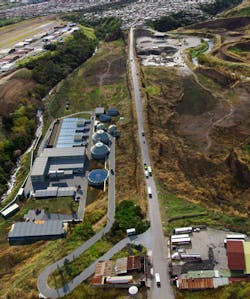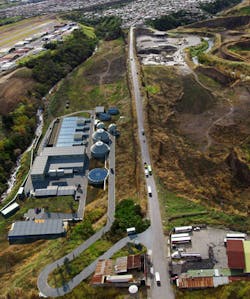Los Tajos Advances San José’s WasteWater Treatment
Like most of Costa Rica, the capital, San José, has low levels of wastewater treatment despite the country’s regional success in terms of living standards. A new project is radically changing this situation.
Mauro Nogarin reports
According to the 2013 UNDP report, Costa Rica has one of the highest rates of development in the region (at 62nd out of 187 countries) and the highest life expectancy in the region (79.4 years). However, only 4% of the wastewater in the country is treated before being dumped in rivers and other water bodies, such as estuaries, reservoirs, bays, gulfs and seas.
In Costa Rica, 73% of the population uses a septic tank and the sanitary sewer system only serves between 20 to 25% of the remainder. In the Greater Metropolitan Area (GAM), a total of 105,789.4 m3/day of wastewater is discharged to the Tiribí, Maria Aguilar, Rivera and Torres rivers, with only 838 m3/day receiving treatment at one of the 20 sewage treatment systems operated by the Costa Rican Institute of Aqueducts and Sewers (AyA) and the Public Service Company of Heredia (ESPH). In addition, most of the sludge collected from septic tank systems is disposed of to waterways, providing another source of pollution.
According to an audit report from the Comptroller General of the Republic (CGR) in 2013, at that time 25 of the country’s 34 watersheds were contaminated. Most of the discharges were linked to domestic wastewater from toilets, showers, sinks and laundry.
As a result, the government has invested $45 million in the new Los Tajos wastewater treatment plant for the country’s capital city, San José. Built by the Spanish company Acciona Agua with AyA, the plant will serve more than one million people: in other words, 65% of the estimated population of the metropolitan area of the capital.
The wastewater treatment plant (WWTP) offers primary treatment (physical-chemical) and complete sludge treatment, and was designed for an average flow of 242,800 m3/day and a maximum flow of 298,000 m3/day. The project also involves rehabilitating and extending the sewage and secondary collector networks over an area of more than 360km.
In the second stage of the environmental improvement plan, besides building a secondary treatment system for a maximum flow of 451,000 m3/day the project will also help to clean up the Tárcoles river basin, reducing the risk to public health and the pollution of the area’s aquifers, and preparing the city for its expected growth in the coming years.
The entire project has been part-financed by the Japan International Cooperation Agency (JICA).
Luis Miguel Lopez-Mier, AyA’s construction director, said: “The environmental improvement project of the metropolitan area of San José has a total cost of US$371 million. Part of this cost was funded by the Japan International Cooperation Agency (JICA) in the amount of $124.6 million, under very favorable credit conditions for project implementation such as a low interest rate, grace period and an extended period for repayment.
An additional $75 million came from the National Bank of Costa Rica, as well as $50 million from the IDB. The contribution from AyA is $77.01 million.”
JICA also provided technical support, as he explained: “In addition to funding, [the project] has received not only financial support, but also the assistance of Japanese experts for the conceptual design of education and environmental awareness program targeting the population that is benefited within 11 counties involved.”
Treatment process
The plant’s treatment systems start with rough and fine filtering, which takes place in collection channels, where 30mm and 6mm bar screens have been installed. Bar screens have automatic cleaning systems and are followed by Pramar degritters and degreasers, which have motorised sluice gates and are swept by a bridge. A deodorising plant collects odours from the covered building. Grit and other deposits are collected using pumps, which feed the water-grit mixture into collection channels that take the mixture to a grit classifier for dewatering and discharge into containers.
Grease is emulsified in a two-stage process that uses the air distribution system: in the first third of the degritter, air is supplied directly by air diffusers, and mechanical aerators supply air in the second third. The final third of the degritter is used for calming. Blowers provide air at a cross circulation speed where turbulence favours separation of organic matter from the grit particles. The second stage is agitated using two 11.2 kW Sulzer mechanical aerators.
Wastewater then goes to the primary settling distribution chamber, where it is distributed to the lamella settling system, which includes sludge thickening and recirculation.
The combined effect of the sludge recirculation and lamella system, supplied by DECANTEK, allows the apparatus to operate with a hydraulic loading, with respect to the settling surface, of between 192 and 336 m3/day, depending on flows. Sludge thickening is achieved using a 20m diameter bridge scraper. Six longitudinal spillways on each side of the settling tank feed wastewater to a flow metering chamber, from where the wastewater is discharged to the Torres river in Stage I of the project, and in Stage II will go on to biological treatment. The biological treatment stages designed by Acciona Agua, will utilise an activated sludge system with aeration diffusers.
Site challenges
Eng. Jose María Trapaga, Acciona’s construction director, explains that the most challenging part of construction was “the digesters, for their cylindrical shape at the base and tapered at the top. Formwork for such structures is not commonly used, nor was the high level of quality required by both the client and our standards.
Another difficulty was the geology of the area, which forced us to resort to the use of explosives to carry out earthworks in the vicinity of government buildings and the adjoining airport. All this was solved with great success on our part.”
Fundamental to the proper functioning of the digestion process is the homogenisation of the sludge using pressurised gas, which is injected into the digester using gas lances.
The gas flow rate has to agitate 668 m3/hour in each digester, and three gas compressors (one in reserve), with a flow rate of 670 m3/hour, are used to generate sufficient gas. Digested volatiles generate CH4 and CO2 as the final product, as well as other gases such as H2S. The generated gas will be cleaned, and distributed either to agitate the digesters or as fuel for the boilers.
Biogas is treated to eliminate moisture and unwanted substances, such as carbon monoxide, hydrogen sulphide, and carbon dioxide. The technology for cleaning Costa Rica’s Tajos WWTP biogas is the Biolimp-MP dry version, which dries by cooling-condensation and the removal of siloxanes via cooling over activated carbon.
The project is currently nearing completion according to Trapaga.
He says: “We are currently in the last phase, which is the assistance operation in which we advise the client, AyA, in all matters relating to the operation of the plant. The most complicated challenge has been coordinating our teams with the teams who were contracted by outside companies for the start up operation, which was hampered by the distance of many kilometers between the parent company and the project.”
Lopez-Mier adds that the project has significantly changed the lives of the people that it serves: “It should be noted that the existing sewage system dates from 1920, so the pipe network has been damaged by aging.
“Existing sewage leaks into rivers and waterways in the metropolitan area, the wastewaters we manage to collect are discharged into rivers, causing serious environmental pollution and damage to public health.”
The project, approved by Law 8559 in 2007, hopes to improve those environmental and public health conditions for the area’s 1,070,000 inhabitants, he adds. Key to the project has been communication with local stakeholders, Lopez-Mier says.
“Notably, the nearest population to the treatment plant is the community of La Carpio, to whom we applied a more direct approach with simpler language, so that they gradually came to understand the importance of connecting to a sanitary sewage system and the improved conditions for their health and the environment.”
Trapaga adds: “We are currently working on a project to build 75km of collectors in the south of San Jose and continue bidding projects in the country that are interesting for the company and the country.”
Costa Rica’s Water Supply and Sanitation responsibility
Responsibility for water and sanitation in Costa Rica is spread across many different institutions and regulated by numerous pieces of legislation. Responsibility for water and sanitation policy is shared between the Ministry of Health (MINSALUD) and the Ministry of Environment, Energy and Telecommunications (MINAET), with other ministries taking minor roles. The economic regulation of the major service providers, AyA and ASADAS, is the responsibility of the Regulatory Authority for Public Services (ARESEP), which sets tariffs and technical standards as well as monitoring compliance. AyA also monitors technical compliance, advises the ministries, and can take over failing systems.
Mauro Nogarin is a freelance correspondent for WWi magazine.
More Water & WasteWater International Archives Issue Articles

